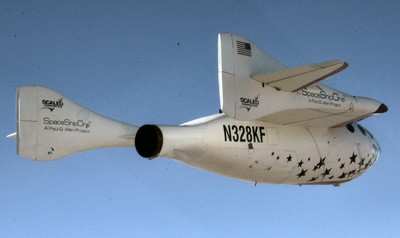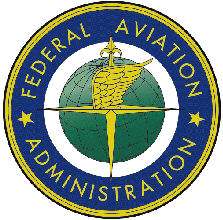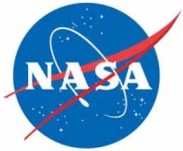Commercial Human Space Flight, Per The FAA
 For the typical person,
the first thing that pops into one's mind when thinking about human
space flight is probably NASA. Right?
For the typical person,
the first thing that pops into one's mind when thinking about human
space flight is probably NASA. Right?
Well, maybe not for those who are regular Aero-News readers. You
know that the US space program is more than NASA or the Air Force -
right? - with three distinct sectors: civilian, military, and
commercial.
And you are familiar with Burt Rutan, Scaled Composites and
SpaceShipOne; Richard Branson and Virgin Galactic; and
other pioneers who have entered the commercial human space flight
industry.
Names you know, like XCOR Aerospace; Rocketplane Kistler; Space
Adventures (whose most famous orbital client, Charles Simonyi, is
currently aboard a Soyuz capsule and bound for the
International Space Station); the X PRIZE Foundation; ProSpace, the
citizens' space lobby dedicated to opening the space frontier; and
PoliSpace, a political consulting firm dedicated to helping space
entrepreneurs and intrapreneurs succeed at the nexus of space
business, technology, and public affairs.
And the spaceports! From California, to Florida; New Mexico to
Oklahoma; Alaska to Wisconsin; and let's not forget Texas, which
has three (they think big in Texas) under development.
But back to the task at hand: to explain the new rules for this
emerging industry. Just this past Friday, the FAA issued
regulations, 24-pages worth, governing the issuance of experimental
permits for launching reusable suborbital rockets. This allows
vehicle developers to experiment and test their vehicles prior to
applying for an FAA launch license. Huh?
First, for those confused by who oversees what, the commercial
sector of the US space program currently falls under the Office of
Commercial Space Transportation (AST) within the FAA, although it
had, at one time, been under jurisdiction of DOT. With me so
far?
The new April 6 guidelines, which you'll find below, come right
on the heels of FAA requirements for crew and passengers involved
in private space travel, reported by ANN, which went into
effect December 31, 2006.
So what does all this mean to you and me?
First let's put it into perspective. As Patricia Grace Smith,
associate administrator, Office of Commercial Space Transportation,
FAA, said in Washington, DC, at the Center for Strategic and
International Studies on March 28, "What a remarkable development
that is people who are not pilots, not scientists, not military
officers, not specialists and, so far, not astronauts, will be able
to take a ride to space."

"It will all be made possible by private entrepreneurs,
investing their own resources in their own dreams and inviting the
public to buy a ticket and join them."
If you have been following the new commercial space enterprises,
as we know that you have as good Aero-News readers, be forewarned
that these new rules will have a significant impact on space
tourism vehicle operators' flight testing, including Virgin
Galactic's SpaceShipTwo, with its inaugural flight
scheduled to fly by May 2008, and others in this emerging
industry.
But feel the warmth of the FAA, who asserts the goal of all
these new rules is to streamline the launch authorization process
during a launch vehicle's development phase. And to help facilitate
testing of those vehicles, the allowable processing time for making
a determination on a permit has been reduced, by law, to 120 days
compared to 180 days for a license.
Sit back for more details
- A single experimental permit will cover multiple launch
vehicles of a particular design and allow an unlimited number of
launches.
- The FAA will identify the type of design changes that may be
made without invalidating the permit.
- The one-year permit is renewable following an FAA review.
- None of the test flights covered by an experimental permit can
be conducted for compensation or for hire.
- The new rules establish criteria for the physical area in which
a launch vehicle with an experimental permit can operate. The area,
among other things, must be large enough to contain planned
trajectories. It cannot contain nor be adjacent to a densely
populated area. (Do I hear a "Duh?")
- As part of the application for a permit, a vehicle developer
will need to provide a program description, a flight test plan, and
operational safety documentation, including a hazard analysis and a
plan for response to a mishap.
 The new rules also call for
launch vehicle operators to provide certain safety-related
information and identify what an operator must do to conduct a
licensed launch with a human on board.
The new rules also call for
launch vehicle operators to provide certain safety-related
information and identify what an operator must do to conduct a
licensed launch with a human on board.
Launch providers must also inform passengers of the risks of
space travel, in the operator's vehicle in particular. Protocols
include training and general training and general security
requirements for space flight participants.
"These rules represent another step forward for commercial human
space flight. To help move this exciting industry from concept to
reality, our goal is to streamline and facilitate the licensing
process for flight testing under the experimental permit while
maintaining public safety," said FAA administrator Marion
Blakey.
Have a few minutes? Take a look back at ANN's Year in Review for 2006
and what transpired in the commercial human space flight
industry.
The new rules were mandated by Congress in the commercial space
launch amendments act 2004. Recognizing that this is a fledgling
industry, the law required a phased approach in regulating
commercial human space flight, with regulatory standards evolving
as the industry matures.
Stay tuned. There's more to come as this new industry reacts to
Friday's announcement.
Space "Tourists" To Date
- #1: May 2001, Dennis Tito, a multimillionaire who paid $20
million and spent 8 days in space as an "independent
researcher."
- #2: April 2002, Mark Shuttleworth, a 28-year old South African
entrepreneur traveled to the ISS aboard the Russian Soyuz TM-34
mission and reportedly paid $20 million for the trip. Left April
25, returned to earth May 5.
- #3: October 2005, Gregory Olsen, a 60-year old entrepreneur,
started his flight to the ISS onboard the Russian Soyuz TMA-7
capsule and reportedly paid $20 million for the 12-day flight
- #4: September 2006: Iranian-born but now American citizen
Anousheh Ansari, the first female space tourist who had an 8-day
expedition aboard the ISS as part of the Expedition 14 crew of the
Soyuz TMA-9
- #5: April 2007: Charles Simonyi, Hungarian-born, but now a US
citizen, billionaire and ex-Microsoft employee who helped develop
Microsoft Word, reportedly paid $25 million for his trip to the ISS
onboard the Russian Soyuz TMA-10, which is currently in
progress.
Significant Milestones in Commercial Human Space Flight
-
 April 1, 2004: AST issues first
launch license for a Reusable Launch Vehicle (RLV) to Scaled
Composites
April 1, 2004: AST issues first
launch license for a Reusable Launch Vehicle (RLV) to Scaled
Composites
- April 8, 2004: Scaled Composites' SpaceShipOne RLV completes
the first private sector human commercial rocket launch
- June 17, 2004: AST issues the first license for an inland
Spaceport to Mojave, CA
- June 21, 2004: AST awards Mike Melville the first commercial
astronaut wings for his successful flight of SpaceShipOne
- October 4, 2004: The XPRIZE, an international competition
established to award private industry a $10 million award for
completing two successful commercial human space flights in the
span of two weeks, is awarded to Scaled Composites for its
successful flights of SpaceShipOne. Brian Binnie, the pilot of the
vehicle, is awarded FAA's second set of commercial astronaut
wings
- May 25, 2005: FAA briefed to its Commercial Space
Transportation Advisory Committee the new guidelines for obtaining
experimental launch permits. Guidelines were publicly released the
same day. Modeled on experimental airworthiness certificates used
in aviation, the permits will allow vehicle developers the
opportunity to experiment and test their vehicles prior to applying
for an FAA launch license.
- December 31, 2006: New FAA requirements went into effect for
crew and passengers involved in private space travel.
- April 6, 2007: FAA finalized the new guidelines for obtaining
experimental launch permits. Modeled on experimental airworthiness
certificates used in aviation, the permits allow vehicle developers
the opportunity to experiment and test their vehicles prior to
applying for an FAA launch license.
 ANN's Daily Aero-Linx (05.06.25)
ANN's Daily Aero-Linx (05.06.25) ANN's Daily Aero-Term (05.06.25): Ultrahigh Frequency (UHF)
ANN's Daily Aero-Term (05.06.25): Ultrahigh Frequency (UHF) ANN FAQ: Q&A 101
ANN FAQ: Q&A 101 Classic Aero-TV: Virtual Reality Painting--PPG Leverages Technology for Training
Classic Aero-TV: Virtual Reality Painting--PPG Leverages Technology for Training Airborne 05.02.25: Joby Crewed Milestone, Diamond Club, Canadian Pilot Insurance
Airborne 05.02.25: Joby Crewed Milestone, Diamond Club, Canadian Pilot Insurance






